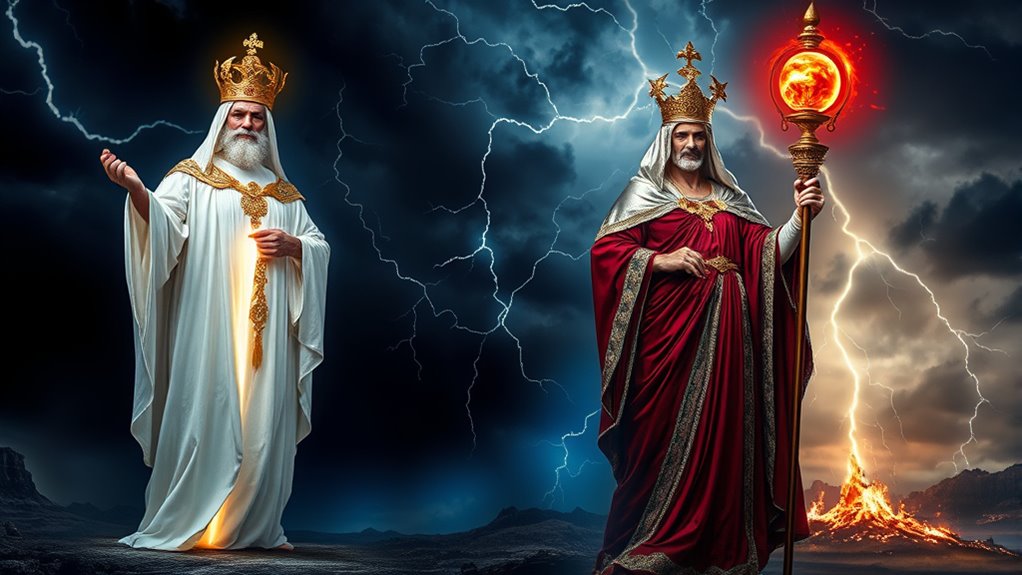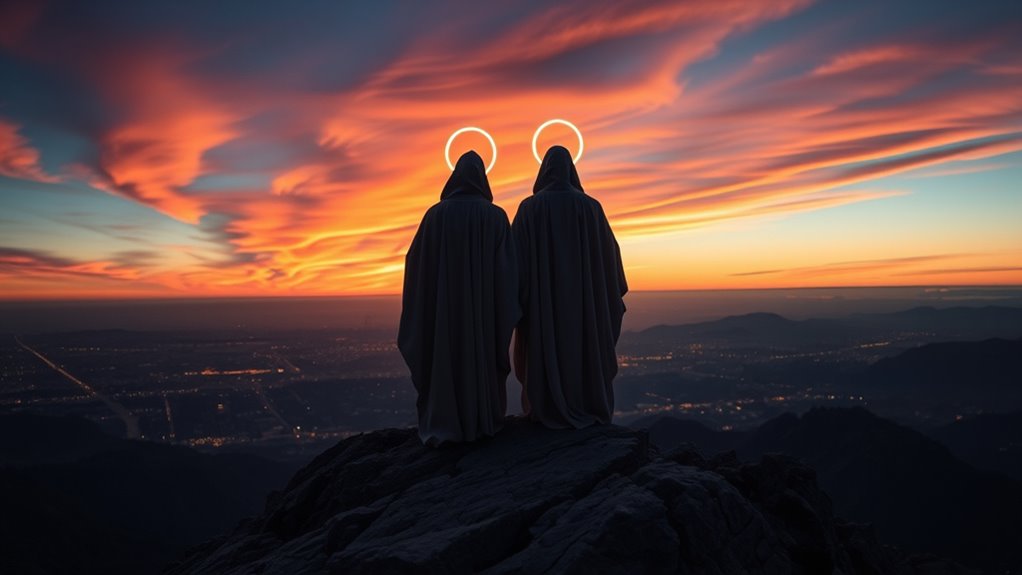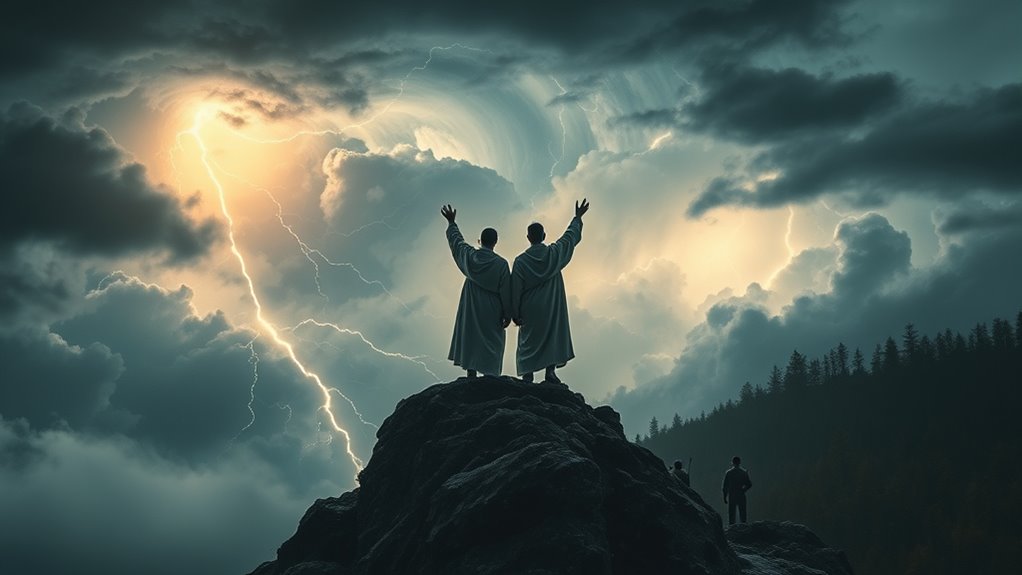The Two Witnesses in biblical prophecy are believed to be divine messengers with supernatural powers, sent during the end times to proclaim God’s truth and confront opposition. Some think they are specific figures like Elijah or Enoch, while others see them as symbolic of faith communities or spiritual truths. Their roles involve miracles, persecution, and divine authority, making their true identity a subject of ongoing debate. If you keep exploring, you’ll discover more about their fascinating significance.
Key Takeaways
- The Two Witnesses are biblical figures described in Revelation 11, symbolizing divine messengers during end times.
- They are often identified as Prophet Elijah and Enoch, based on biblical significance and prophetic symbolism.
- Their supernatural powers include fire from their mouths, shutting heaven, and raising the dead, emphasizing divine authority.
- Interpretations vary: some see them as literal future individuals, others as allegories for faith communities or spiritual truths.
- Their role signifies divine judgment, perseverance, and the ongoing prophetic witness amid chaos and opposition.
Biblical Foundations and Scriptural Descriptions

The biblical foundations for the Two Witnesses are rooted in Revelation 11, where they are described as two prophetic figures who will appear during the end times. These figures are rich in apocalyptic symbolism, representing divine witnesses tasked with proclaiming God’s message. Their roles symbolize justice, judgment, and divine authority amid chaos. The imagery used in Revelation emphasizes their supernatural powers, such as fire coming from their mouths and the ability to shut heaven, highlighting their divine origin. As divine witnesses, they serve as God’s messengers, testifying to truth and righteousness during tumultuous times. Their appearance signifies a pivotal moment in biblical prophecy, reinforcing their importance as agents of divine justice and the fulfillment of God’s final plans.
Historical Interpretations of the Witnesses

Throughout history, people have offered different views on the biblical origins and symbols of the Two Witnesses. During the medieval and Reformation periods, interpretations shifted based on theological debates and societal changes. Today, modern debates continue as scholars analyze these figures through new perspectives and historical contexts.
Biblical Origins and Symbols
Biblical scholars have long debated the origins and symbolism of the Two Witnesses described in Revelation 11, viewing them as representations of divine truth and prophetic authority. Their imagery is rich with apocalyptic symbolism, emphasizing themes of judgment and divine intervention. The witnesses are often seen as embodying prophetic imagery that highlights their role as messengers of God’s will during tumultuous times. Some interpret their attire, abilities, and death as symbolic of spiritual victories and struggles in the biblical narrative. Their prophetic symbolism underscores the importance of divine revelation, serving as a reminder of God’s sovereignty amid chaos. By examining these symbols, you gain insight into how the early church understood the witnesses as essential bearers of truth within apocalyptic contexts.
Medieval and Reform Periods
During the Medieval and Reformation periods, interpreters of Revelation 11 often viewed the Two Witnesses as symbolic figures representing the church’s enduring faith and divine authority amid chaos. This perspective relied heavily on medieval symbolism, portraying the witnesses as spiritual protectors during turbulent times. In reform era debates, their identity was hotly contested, with some seeing them as pivotal reformers or church figures. Key interpretations include:
- Symbols of the faithful church resisting persecution.
- Representatives of divine authority challenged by secular powers.
- Allegories of reformers standing against corruption.
- Embodiments of spiritual truth amidst chaos.
These readings reflect the era’s desire to find divine purpose in upheaval, shaping how people understood biblical prophecy during times of societal change.
Modern Interpretations and Debates
Modern scholars and theologians have debated the true nature and identity of the Two Witnesses, often revisiting historical interpretations to understand their significance. They see the witnesses as embodying faith symbolism, representing steadfast believers or the church’s resilience during tribulation. Others interpret them through prophetic symbolism, viewing them as symbolic figures or nations fulfilling biblical prophecy. These debates highlight how interpretations evolve, influenced by different theological traditions and cultural contexts. Some believe the witnesses symbolize specific historical figures or institutions, while others see them as timeless symbols of divine truth. By examining these modern debates, you gain insight into how faith and prophetic symbolism shape ongoing discussions about the witnesses’ roles and meanings in biblical prophecy.
Common Theories About Their Identities

Many believe the witnesses are Prophet Elijah or Enoch, based on their biblical significance. Others see them as a symbolic representation of God’s law and truth during times of chaos. Some interpret the witnesses as literal future figures who will appear in eschatological events.
Prophet Elijah or Enoch
The identities of the two witnesses in Revelation have sparked widespread debate, with some scholars asserting that they are prophets Elijah or Enoch. They argue that these figures embody prophetic symbolism and serve as angelic messengers during critical times. Here are key points supporting this view:
- Elijah’s fiery chariot and ascension symbolize his prophetic role and divine connection.
- Enoch’s biblical departure without death makes him a candidate for the witnesses’ immortality.
- Both figures represent the law and prophets, highlighting their spiritual authority.
- Their identities align with the idea of angelic messengers, sent to fulfill divine purposes in apocalyptic events.
While interpretations vary, many see Elijah or Enoch as fitting candidates due to their biblical significance and prophetic symbolism.
Symbolic Representation of Law
Elijah and Enoch are often viewed not only as prophets but also as symbols representing the Law within biblical tradition. This law symbolism emphasizes their roles as embodying divine authority and righteousness. In this context, their prophetic imagery highlights their connection to divine judgment and moral truth. Some interpret the two witnesses as personifications of God’s law—Elijah symbolizing the prophetic voice that calls for justice, Enoch representing the righteous who uphold divine standards. Their presence signifies the enduring nature of God’s commandments and the importance of adhering to spiritual law. By viewing them through this symbolic lens, you see how biblical imagery connects prophetic figures with the foundational principles of divine law, reinforcing their role as witnesses to God’s eternal commandments.
Literal Future Witnesses
Who are the two witnesses described in Revelation, and could they be actual future individuals? Many believe these divine witnesses are literal figures who appear during the end times to prophesy and confront evil. Common theories suggest:
- They are two specific prophets from the Old Testament, like Moses and Elijah.
- They symbolize the church’s ongoing witness during the end times.
- They are two future individuals, chosen by God to serve as divine witnesses.
- They represent the faithful remnant, testifying until Christ’s return.
These interpretations highlight the possibility that the witnesses are real people, destined to play essential roles in the final days, emphasizing their significance in biblical prophecy about the end times and divine witnesses.
Symbols and Significance in Prophecy

Symbols in prophecy serve as powerful tools to convey complex messages and divine truths that might be difficult to express with words alone. They use divine symbolism and prophetic imagery to communicate spiritual realities beyond literal meaning. For instance, a lamp or a mountain can represent divine guidance or strength, helping you grasp deeper spiritual concepts. These symbols often point to larger truths about God’s plan and His messengers, making them essential for understanding prophetic messages. Recognizing these symbols allows you to interpret the significance behind visions and predictions more accurately. By paying attention to the divine symbolism, you can uncover hidden insights and better appreciate the divine message woven throughout prophetic scripture.
The Role of Miracles and Persecution

Miracles and persecution often reveal the divine power and opposition encountered by God’s messengers. Miraculous signs demonstrate God’s authority through the witnesses, strengthening faith and confirming their message. Persecution dynamics show how opposition intensifies when divine power becomes evident. To understand this better:
Miracles affirm divine authority; persecution tests faith and reveals true messengers.
- Miraculous signs authenticate the witnesses’ divine commission.
- Persecution reveals the hostility faced when confronting false teachings.
- Miracles often provoke resistance from adversaries.
- The witnesses’ endurance under persecution highlights their crucial backing.
These elements work together, emphasizing the significance of divine intervention and human opposition. As you observe these aspects, you’ll see how miracles serve as divine confirmation, while persecution tests the witnesses’ resolve, illustrating their essential role in prophetic testimony.
Debates and Controversies Surrounding Their Identity

The identity of the Two Witnesses has sparked intense debate among scholars and theologians for centuries. You’ll find that cultural influences shape many interpretations, as different traditions see them through varied lenses. Some believe they symbolize specific historical figures, while others view them as representing broader spiritual truths. Literary symbolism also plays a significant role, as the descriptions evoke imagery found in apocalyptic writings and prophetic texts. These symbolic elements lead many to see the witnesses as allegories rather than literal individuals. Controversies persist because interpretations depend heavily on cultural context and literary interpretation. As a result, debates remain lively, with no consensus in sight, fueling ongoing discussions about who these witnesses truly are and what they represent within the broader biblical narrative.
Modern Perspectives and Theological Views

Modern perspectives on the Two Witnesses often focus on their spiritual significance and how they reveal God’s ongoing work in the world. Many see them through the lens of apocalyptic imagery and prophetic symbolism, emphasizing their role in confronting evil and restoring faith. Consider these key ideas:
- They symbolize the church’s witness amid chaos and persecution.
- Their presence reflects divine authority during times of crisis.
- Apocalyptic imagery underscores their role in final spiritual battles.
- Interpretations vary, with some viewing them as literal figures, others as allegories for faith communities.
These perspectives highlight how the witnesses serve as powerful symbols of hope, perseverance, and divine justice amid turbulent times. Their imagery continues to inspire theological reflection on God’s ultimate plan.
Frequently Asked Questions
Are the Two Witnesses Literal or Symbolic Figures?
You wonder if the two witnesses are literal or symbolic figures. Many interpret the symbolic symbolism as representing broader spiritual truths, while others prefer a literal interpretation, seeing them as actual people. It depends on your perspective and how you approach biblical prophecy. Whether you see them as real individuals or symbolic representations, both views aim to understand the message and significance behind their presence in the story.
How Do Different Christian Denominations Interpret the Witnesses?
Imagine peering through a stained-glass window, catching different colors and shapes depending on your perspective. That’s how you see interpretation variations among Christian denominations regarding the witnesses. Some view them as literal prophets, others see symbolic figures representing faith and truth. These differing interpretations carry significant doctrinal implications, shaping beliefs about prophecy, end times, and divine authority, influencing how each denomination understands their role in God’s plan.
What Is the Timeline of the Witnesses’ Prophetic Appearances?
You want to understand the chronological sequence of the witnesses’ prophetic timeline. They appear midway through the tribulation, often around the third or fourth year, and prophesy for 1,260 days. Their appearance marks a significant event before the final judgments. Keeping track of this timeline helps you grasp how their prophetic role fits into the larger end-times narrative, emphasizing their importance in God’s divine plan.
Do the Witnesses Represent Specific Historical Figures?
You might wonder if the witnesses symbolize specific historical figures. In symbolic interpretations, they often represent broader spiritual truths rather than individual people. Some believe there are historical correlations, linking them to key prophets or figures in history, but these are interpretations rather than definitive facts. Ultimately, their primary purpose is to convey divine testimony and faithfulness during critical times, rather than to identify particular individuals.
How Do Cultural Perspectives Influence Interpretations of the Witnesses?
You see, cultural perspectives shape how you interpret symbolic stories. Cultural symbolism influences your understanding of figures and events, coloring perceptions with traditions and beliefs. Interpretive biases can lead you to see what aligns with your culture while missing other meanings. By recognizing these biases, you can broaden your view, appreciating diverse interpretations, and understanding that cultural backgrounds deeply impact how you perceive and explain symbolic witnesses in any story or prophecy.
Conclusion
As you explore the various theories about the two witnesses, it becomes clear that their true identity remains a mystery. While some believe they symbolize Israel and the Church, others see them as specific prophetic figures like Moses and Elijah. Ultimately, the emphasis should be on their divine purpose—witnessing God’s truth amidst persecution. Recognizing the symbolism and spiritual significance encourages you to remain steadfast, trusting that God’s plan will unfold according to His divine timeline.










